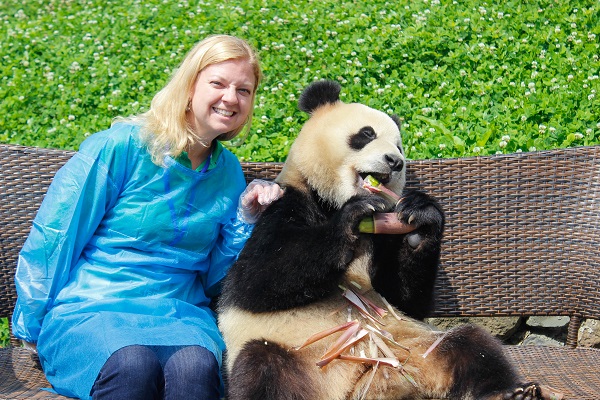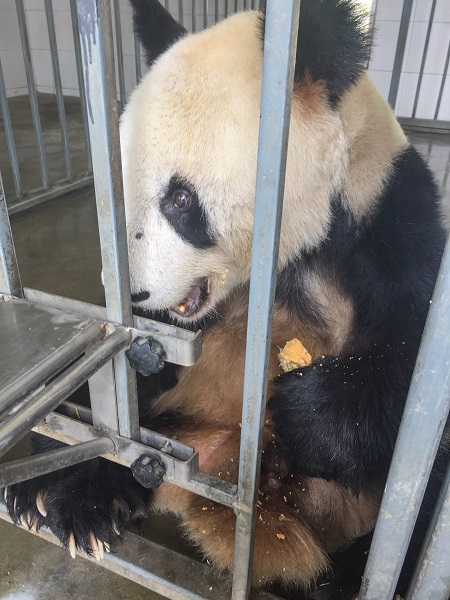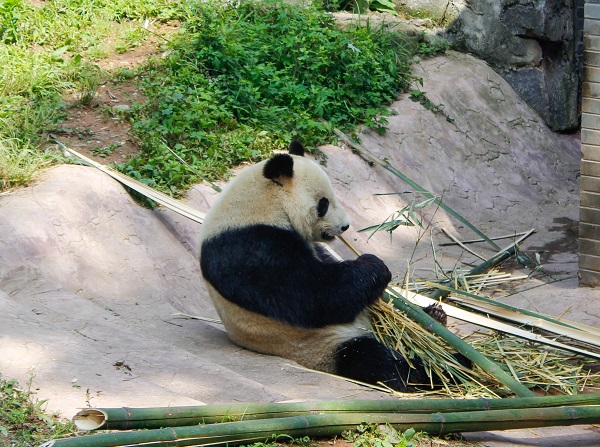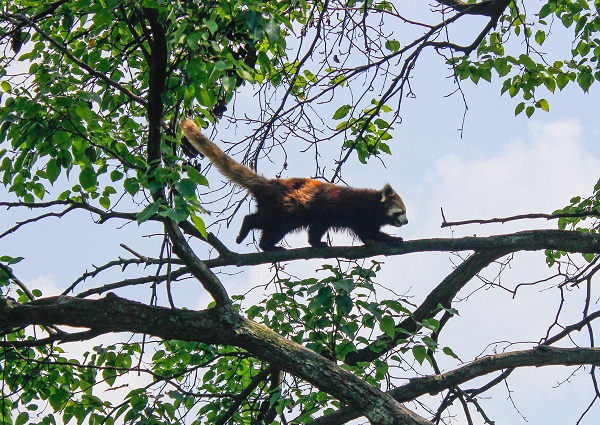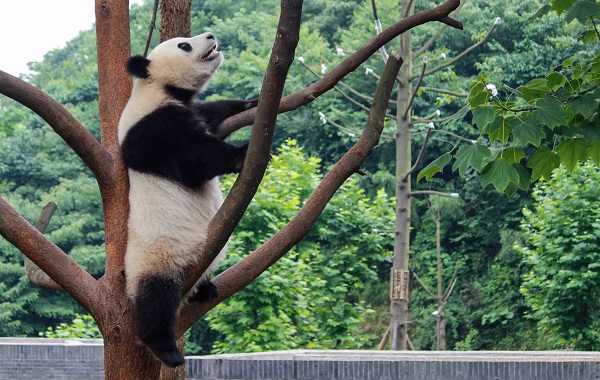
When I started planning my recent trip to China, I knew I wanted to visit Chengdu to see China’s famous giant pandas. Most tourists go to the Chengdu Giant Panda Breeding Research Base to catch a glimpse of this endangered animal, but the base doesn’t offer any opportunities to get up close and personal with the pandas. That was fine with me until I discovered there was another option: I could volunteer with pandas at the relatively new Dujiangyan Base of the China Conservation and Research Center for the Giant Panda (CCRCGP), also just outside of Chengdu near the city of Dujiangyan.
I learned about Dujiangyan on a tour company website – and the tour company wanted to charge me a whopping $600 to take me to the center and back. As I investigated more, I found several other companies offering this option, but all charging upwards of $400 for a solo traveler. If you’re like me, your reaction to that is “oh hell no!”
But the internet is vast and as I dug deeper, I found detailed information about how to volunteer with pandas at the center, how to get there and contact information for the center itself. I reached out and they responded quickly, informing me it was around $100 to volunteer for a day and sending me an application form and a medical form to be completed by my doctor. The medical form was a little intimidating as it asked for all sorts of information and test results that are not typically part of a routine physical in the United States (like an EKG and chest x-ray!). Luckily, my contact at the center said I could skip those.
I arrived in Chengdu the afternoon before I was scheduled to volunteer. The desk person at my hotel in the center of the city told me to take a bus from the Cha Dian Zi bus station to Dujiangyan, where I could either catch a taxi or take bus 23 to the panda center. I was told buses left every 15 minutes beginning at 6:30 a.m., but it turned out the buses didn’t start leaving until 7:00 and the bus I got on didn’t leave until about 7:15.
I arrived in Dujiangyan an hour later and caught bus 23 from out in front of the bus station. It was a local bus so it stopped often, which meant it took about 45 minutes to get to the panda center! Also, the center is not a normal stop on the route, so I had the name of the center written in Chinese for me to show the bus driver so he could tell me where to get off. While I was supposed to be there by 8:45, I didn’t arrive until just after 9:00.
What I should have done instead was take the train from Chengdu to the Qingcheng Mountain Station or take the bus all the way to QingCheng. Bus 23 also runs from QingCheng to the panda center, but it is only about 10-15 minutes away instead of 45! Alternatively, I could’ve still taken the bus to Dujiangyan, but caught a taxi instead, which would have been more direct. Note that if you do the train, book your train in both directions at least a day in advance as they do sell out!
Either way, transport both ways cost no more than about $15, so I was saving a huge amount over booking the whole thing with a tour company!
Once I arrived, an English-speaking guide named Elsa met me and ushered me back to an office where a French couple was getting checked in to volunteer as well. I paid the fee in cash, picked up a long-sleeve, bright green volunteer shirt and slipped a volunteer lanyard around my neck. We were able to keep our cameras and phones with us and, in addition to the pictures I took with my phone, Elsa would often grab my camera to take pictures of me in action.
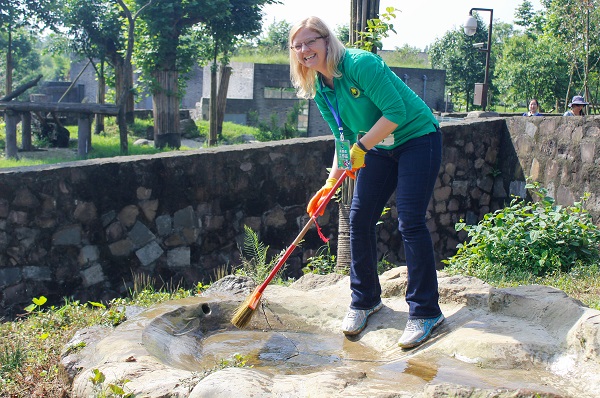
I started in the enclosure for Tai Shan, a giant panda who coincidentally was born in 2005 at the National Zoo in Washington, D.C. – just a 10-minute walk from my home! Elsa introduced me to Tai Shan’s keeper, who spoke just a few words of English. My first task was to help her clean Tai Shan’s indoor and outdoor enclosures, starting with sweeping up panda poo outside.
I immediately regretted not putting my hair into a ponytail as the wind blew it every which way (but mostly in my face) as I tried to shovel large chunks of yellow-colored panda poo into a metal dustpan. I also realized I had an audience as a group of Chinese tourists gathered near a wall overlooking the enclosure, their eyes fixed on my every move. Luckily, there wasn’t a whole lot of panda poo to be cleaned up outside, so I soon moved inside. After scooping up all the poo in there, I sprayed down the pen and scrubbed the walls clean before moving on to a second enclosure.
After cleaning came a break during which Elsa led me and the French couple around the park to look at both giant pandas and red pandas. Then I got to spend a whole 30 seconds getting my picture taken with a baby panda. I paid extra for this and it wasn’t cheap – and if I had known for sure what was to come next, I may not have bothered, but I considered it a donation to a good cause so it didn’t bother me too much (and it was still less than the $600 I would have paid to go through a tour company, where most of my money would not have gone to the panda center at all!).
Next up was the highlight of the day for me – feeding the pandas!!
I got to feed both Tai Shan and another panda, Yuan Yuan. The keeper showed me how the pandas were trained to put an arm through the cage door and grab onto a shelf sticking out from the door to signal that they were ready to eat. Once each did that, I would give them a bit of “panda cake” – a homemade concoction of soy, vegetables and a few other ingredients, all designed to provide the pandas with more nutrients than their typical diet of bamboo offers. Needless to say, this was SO COOL. (side note: check out the size of the claws in the pictures below!)
And I got to do it again in the afternoon!
The rest of the volunteer experience consisted of eating lunch in the staff cafeteria, breaking up bamboo and carrying it into the panda enclosures, watching a documentary about efforts to train pandas for release into the wild (which was produced by National Geographic so I had already seen it when it screened at work!), making panda cakes ourselves in the “panda kitchen” and spending another hour wandering around the center watching the pandas.
We lucked out because pandas typically don’t care for the afternoon heat and get quite lazy, often retreating to their indoor spaces to get out of the sun. But it clouded over and cooled off by about 3:00 p.m., just as we finished up everything else, so there were quite a few pandas out and about when we did our last lap around the center.
All in all, the opportunity to volunteer with pandas was a once-in-a-lifetime experience that was well worth it! I occasionally felt like we were causing more work for the keepers than really helping, but I thought the whole experience was well-designed to give volunteers a taste of what is required to care for the pandas. And after being so close to them, I can’t imagine anyone leaving and not caring more about protecting these adorable animals. Not to mention, the fees benefit panda research and conservation, so it seems to be a win-win overall.



